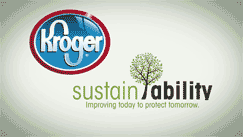Not to be outdone by Walmart, Unilever and Target, Kroger, the second largest US retailer, recently released its 2016 sustainability report, with an aggressive set of goals for sustainability achievement along multiple dimensions.
Thought not nearly as dramatic in terms of its social ambitions as the letter from Walmart CEO Doug McMillon earlier in the year in the release of its sustainability report (See Review of Walmart's 2016 Global Responsibility Report), Kroger CEO Rodney McMullen notes that "Our goal is to be a positive force for change in our communities and to conscientiously drive sustainability and innovation into the supply chain."
McMullen says more and more, "customers care and want to know how Kroger positively influences the supply chain - from raw materials and ingredients, manufacturing inputs, labor practices and animal welfare," saying the company has programs in place to address many aspects of a complex and dynamic food system.
That include a specific focus on what it calls "high-impact commodities," or those items that have been identified as having the potential for substantial social, environmental, and/or economic impacts due to where and how they are produced or processed.
Kroger has a slew of programs to address how it sources and manages these high impact categories. For example, it earlier had set a goal to source 100% of its top 20 wild-caught species (by volume) from fisheries that are Marine Stewardship Council (MSC) certified or on the path to certification. It fell just short of that goal in 2015, at 86%. It is also working with MSC on a number of "fishery improvement projects" (FIPs) to help make supplier fishing operations more sustainable, funding five of these FIPs last year and sourcing from more than a dozen more suppliers involved in FIP programs.
Kroger notes that it uses a Supplier Information Management (SIM) system to automate supplier qualification, set-up, and communication processes. The SIM system helps it maintain a common set of data on all of its existing and potential suppliers, "increasing visibility across our vast sourcing network," Kroger says, adding that "The data is housed in one central location and accessible to qualified associates across the company. Sourcing teams are able to easily identify suppliers who are, or are not, qualified to do business with us."
Kroger says it has a supplier audit program, although it appears less mature at this point versus programs at Apple, Walmart and others. It has focused its audits on the following areas: child and forced labor, disciplinary practices, discrimination, environment, ethics, freedom of association, health and safety, monitoring sub-tier supplier compliance, subcontracting, working hours and compensation.
It notes the company has just recently published the questions used in its supplier audits, so that its suppliers can understand Kroger's expectations prior to an audit taking place. Those question can be found here: Kroger supplier audit questions
 Without giving specifics, the Kroger report says that it has more than doubled its number of social compliance audits in 2015 from the previous year and "implemented a robust process to analyze and act upon the results of the audits." Without giving specifics, the Kroger report says that it has more than doubled its number of social compliance audits in 2015 from the previous year and "implemented a robust process to analyze and act upon the results of the audits."
On the environmental side, Kroger said that it has been measuring and managing its total carbon footprint, and that is has has decreased its total "normalized" footprint by 9.3% (tCO2e/1,000 square feet of retail space.) since 2006. In 2015, Kroger's total carbon footprint decreased on an absolute basis by 3.8% as compared to 2014.
Kroger notes that it operates what it calls the Kroger Recovery System at the Ralph's/Food 4 Less distribution center in Compton, CA, a system which has been in operation since 2013. It utilizes "anaerobic digestion," a naturally occurring process that transform food waste into renewable biogas. It has an annual capacity to process 46,500 tons of food waste. (In this circumstance, food waste is food that cannot be sold or donated as well as on-site dairy processing effluent.)
Many don't realize that Kroger has substantial manufacturing operations, mostly in the bakery and dairy areas. It notes in the report that in 2015, 31 of its 33 corporately managed manufacturing plants were designated as "zero waste" facilities. Last year, Kroger plants reduced the amount of waste sent to landfill by 49.3% from 2014.
Kroger is also aggressively moving to use of reusable plastic containers (RPCs) to move food, especially produce, to its stores versus corrugate boxes. In 2015, Kroger shipped 106 million RPCs of fresh produce, which it estimates eliminated the use of more than 73,500 tons of waxed and corrugated boxes.
On the logistics front, Kroger says had set a goal of improving its fleet efficiency by 40% in 2015 over a 2008 baseline. It actually exceeded that goal, achieving a 51% improvement in cases shipped per gallon of diesel used.
In 2015, Kroger increased its truck utilization, defined as cube per load, by 0.86% compared to 2014. The goal for 2015 was to improve our truck utilization by 15% compared to our 2008 baseline and Kroger achieved13% improvement, just shy of the goal.
Moving forward, Kroger will be tracking Ton Miles Per Gallon (TMPG) as the key measure of logistics efficiency, effectively looking at how many miles Kroger moves one ton of groceries on one gallon of fuel. Kroger says it is committed to improving TMPG by 20% by 2020.
There is a lot more, but you get the idea. The full report can be found here: 2016 Kroger Sustainability Report
Any reaction to this year's Kroger Sustainability report? Let us know your thoughts at the Feedback button below.

|